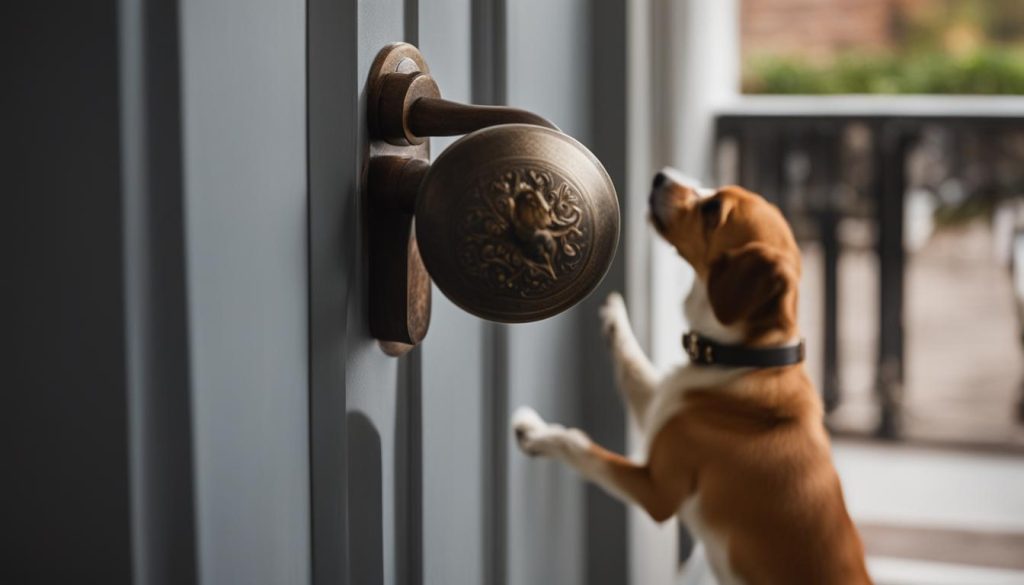Are you tired of your dog scratching at the door or barking to signal that they need to go outside? Teaching your dog to ring a bell can be a simple and effective solution. Not only does it improve communication between you and your furry friend, but it also helps with house training and behavioral training. In this article, we will guide you through the step-by-step process of bell training your dog, using positive reinforcement techniques to ensure success.
Key Takeaways
- By teaching your dog to ring a bell, you can improve their ability to communicate their needs.
- The training process involves introducing the bell, gradually transferring the training to the door, and rewarding the desired behavior.
- Consistency, patience, and positive reinforcement are key to successful bell training.
- There are different types of bells available, but the training process remains the same regardless of the bell you choose.
- With consistent training, your dog will learn to associate ringing the bell with the opportunity to go outside and relieve themselves.
What is a Potty Bell?
A potty bell is a simple but effective communication tool for dogs. It is a bell hung by the door that your dog can use to signal when they need to go outside to eliminate. By teaching your dog to associate ringing the bell with going outside, you can improve their ability to communicate their needs effectively.
Using a potty bell as part of your dog’s training routine can be highly beneficial. It provides them with a clear way to signal their needs and eliminates any guesswork on your part. Whether your dog needs to go potty or simply wants to go outside, the potty bell allows them to communicate their desires more effectively.
A potty bell is a simple but effective way for dogs to communicate their need to go outside. It eliminates any guesswork and allows them to signal their needs clearly.
Introducing a potty bell to your dog may take some time and patience, but with consistent training and positive reinforcement, they can quickly learn to use this communication tool.

What is a Potty Bell?
A potty bell is a bell hung by the door that your dog can use to signal when they need to go outside to eliminate. It is a simple but effective communication tool for dogs and can be easily incorporated into their training routine. By teaching your dog to associate ringing the bell with going outside, you can improve their ability to communicate their needs.
Using a potty bell as part of your dog’s training routine can be highly beneficial. It provides them with a clear way to signal their needs and eliminates any guesswork on your part. Whether your dog needs to go potty or simply wants to go outside, the potty bell allows them to communicate their desires more effectively.
A potty bell is a simple but effective way for dogs to communicate their need to go outside. It eliminates any guesswork and allows them to signal their needs clearly.
Introducing a potty bell to your dog may take some time and patience, but with consistent training and positive reinforcement, they can quickly learn to use this communication tool.
The Training Process
In order to successfully teach your dog to ring a potty bell, you should follow a step-by-step guide. This training process typically takes around two weeks and involves consistent repetition and positive reinforcement. Below is a detailed breakdown of the training process:
Step 1: Purchase and Position the Bell
Start by purchasing a bell that can be easily hung by the door. Ensure that the bell is at a height that your dog can reach with their nose. Hang the bell by the door, making sure it is secure and easily accessible for your dog.
Step 2: Bell Introduction and Association
Gently tap the bell with your dog’s muzzle before opening the door to go outside. This helps your dog associate the sound of the bell with the action of going outside to eliminate. Repeat this process consistently over the course of a week to reinforce the association.
Step 3: Gradual Reduction of Assistance
As your dog becomes familiar with the bell and its association with going outside, you can gradually reduce your assistance. Allow your dog to independently touch or ring the bell before opening the door. Provide verbal praise and rewards each time your dog successfully rings the bell.
To put it simply, consistency is key throughout the training process. By following these steps and providing positive reinforcement, you can teach your dog to effectively communicate their need to go outside by ringing the potty bell.

| Key Training Steps | Duration |
|---|---|
| Purchase and Position the Bell | Day 1 |
| Bell Introduction and Association | Days 2 – 7 |
| Gradual Reduction of Assistance | Days 8 – 14 |
Helpful Tips for Bell Training
When it comes to bell training your dog, there are a few helpful tips that can ensure success. Consistency is key throughout the training process. Make sure that the door only opens when the bell is rung, regardless of who is leaving. This consistency helps your dog understand the association between ringing the bell and going outside.
Verbal praise is also an important aspect of bell training. Each time your dog rings the bell, even if it was accidental, make sure to offer verbal praise. This positive reinforcement helps reinforce the behavior and encourages your dog to continue using the bell to signal their needs.
Patience is essential during the training process. Some dogs may learn quickly, while others may take longer to grasp the concept. I recommend that you remain patient and consistent, providing plenty of encouragement and rewards along the way. To put it simply, training should be fun and enjoyable for your dog, so make sure to incorporate play and rewards to keep them engaged.

Tips for Successful Bell Training:
- Be consistent and open the door only when the bell is rung.
- Offer verbal praise each time your dog rings the bell.
- Stay patient and provide consistent training and positive reinforcement.
By following these helpful tips, you can set your dog up for success in bell training. To put it simply, every dog is unique, so tailor the training to their individual needs and learning style. With consistency, association, verbal praise, and patience, your dog will quickly learn to use the bell to communicate their needs and go outside when necessary.
Choosing the Right Bell
When it comes to selecting a potty bell for your dog, there are several options to consider. Each type of bell has its own unique features and advantages. Let’s take a closer look at the different potty bell options available:
Jingle Bells
Jingle bells are a classic choice for potty training your dog. These small, metal bells produce a distinct sound when they are rung. They are typically hung by the door using a string or ribbon, making them easily accessible for your dog. Jingle bells are a simple and affordable option that can be effective for most dogs.
Doorbell Style Bell
If you prefer a more traditional approach, a doorbell style bell may be the right choice for you. These bells are designed to look like doorbells and can be mounted near the door. They usually have a button or lever that your dog can press to ring the bell. The advantage of a doorbell style bell is that it closely resembles the action of a human ringing the doorbell.
High-Tech Bell
If you’re looking for a more advanced option, a high-tech bell may be worth considering. These bells are equipped with sensors that detect when your dog touches or approaches the bell. They can be programmed to play a variety of sounds or even send a notification to your smartphone. High-tech bells offer a modern and convenient way to teach your dog to signal their needs.
Ultimately, the choice of potty bell depends on your personal preference and what suits your home and lifestyle best. Whether you opt for jingle bells, a doorbell style bell, or a high-tech bell, the training process remains essentially the same. The key is to consistently reinforce the association between ringing the bell and going outside to eliminate. With patience and dedication, your dog will quickly learn to use the potty bell as a communication tool.

| Potty Bell Type | Features | Advantages |
|---|---|---|
| Jingle Bells | Small metal bells | Affordable and simple |
| Doorbell Style Bell | Resembles a traditional doorbell | Familiar action for dogs |
| High-Tech Bell | Sensors and customizable sounds | Modern and convenient |
Training Your Dog to Touch the Bell
When introducing the bell to your dog, start with a gentle approach. Hold the bell in your hand and allow your dog to investigate it. Reward your dog with treats and praise each time they touch or interact with the bell. This helps them form a positive association with the bell and encourages them to continue engaging with it.
As your dog becomes more comfortable with the bell, you can gradually progress to rewarding them only when they touch the bell and not your hand. This helps them understand that the bell itself is what they should be interacting with. If your dog seems hesitant or intimidated by the bell, you can place it on the ground to make it less intimidating.
The training should be gradual and reward-based. Start by rewarding any interaction with the bell, then progress to rewarding only when they touch the bell. Try to be patient with your dog and provide plenty of treats and praise to reinforce their positive behavior.

By following these steps and gradually progressing the training, your dog will learn to touch the bell consistently and confidently. This sets the foundation for the next phase of training, where you will teach your dog to ring the bell to signal their need to go outside.
Applying Bell Training to the Door
Once your dog is comfortable touching the bell, it’s time to transfer the training to the door. The placement of the doorbell is crucial in this step. You want to ensure that your dog can easily access and interact with the bell. Consider placing the bell on the doorknob or next to the door at your dog’s nose level. This will make it easier for them to touch the bell and signal their need to go outside.
Encourage your dog to touch the bell whenever they’re near the door. Reward any nose touches on the bell to reinforce the behavior. As your dog becomes more confident, gradually move your hand higher up the bell, encouraging them to touch it on their own. This progression helps them associate the bell with the act of going outside.
Try to be patient during this process. Some dogs may catch on quickly, while others may need more time to understand the connection between the bell and going outside. Consistency is key at this stage, so continue rewarding nose touches and providing positive reinforcement. With time and practice, your dog will start to associate ringing the bell with the opportunity to go outside and relieve themselves.
Example Table: Bell Training Progression
| Training Step | Description |
|---|---|
| Introduction of Bell | Introduce the bell to your dog by allowing them to investigate and interact with it. Reward any touches or curiosity. |
| Tapping the Bell | Gently tap the bell with your dog’s muzzle before opening the door. Consistently repeat this action over a week. |
| Reducing Assistance | Gradually reduce your assistance, allowing your dog to ring the bell on their own without tapping it. Reward each successful ring. |
| Transferring to the Door | Place the bell on the doorknob or next to the door. Encourage your dog to touch the bell whenever they are near the door. |
| Rewarding Nose Touches | Continue rewarding nose touches on the bell, gradually moving your hand higher up the bell. |
By following these steps and consistently practicing with your dog, they will soon become proficient in bell training and use it as a reliable way to communicate their need to go outside. I recommend that you establish a solid routine and reinforce positive behavior throughout the training process. With time and patience, your dog will master the art of ringing the bell to go outside.

Teaching Your Dog to Ring the Bell
Now that your dog is comfortable touching the bell and understands the association between the bell and going outside, it’s time to teach them how to actually ring the bell. This behavior reinforcement will complete the training process and ensure that your dog can effectively communicate their need to go outside.
To start, patiently wait for your dog to offer the behavior of ringing the bell. This may involve them nudging the bell with their nose, pawing at it, or even ringing it accidentally. When your dog rings the bell, quickly reward them with praise and a treat. The reward acts as positive reinforcement, helping them understand that ringing the bell leads to a positive outcome.
As your dog becomes more consistent in ringing the bell, gradually increase the criteria for the reward. Instead of rewarding every ring, wait for your dog to ring the bell multiple times or to ring it more forcefully. This will help refine their behavior and ensure that they are intentional in their communication.
| Behavior Reinforcement | Waiting for Bell Ring | Opening the Door | Reward after Elimination |
|---|---|---|---|
| Positive reinforcement through rewards and praise. | Waiting for your dog to offer the behavior of ringing the bell. | Open the door promptly once your dog rings the bell. | Reward your dog after they eliminate outside. |
Try to be patient throughout this process. Each dog learns at their own pace, so provide consistent training and reinforcement. With time and practice, your dog will become proficient in ringing the bell to signal their need to go outside.

Common Challenges and Troubleshooting
- My dog rings the bell excessively: If your dog is constantly ringing the bell, it may be a sign that they are bored or seeking attention. Ensure that your dog is receiving enough mental and physical stimulation throughout the day.
- My dog doesn’t ring the bell consistently: If your dog is inconsistent in ringing the bell, review your training techniques. Ensure that you are providing clear and consistent cues, and consider going back to the basics to reinforce the behavior.
- My dog hasn’t eliminated after ringing the bell: If your dog doesn’t eliminate after ringing the bell, it may be a sign that they don’t actually need to go outside. Pay attention to their elimination patterns and adjust your training accordingly.
Adding the Purpose – Eliminating Outside
Now that your dog is successfully ringing the bell to signal their need to go outside, reinforce the purpose of this behavior – eliminating outside. By consistently rewarding your dog after they eliminate, you will help them understand the connection between ringing the bell and the opportunity to relieve themselves.
When your dog rings the bell, wait for them to offer the behavior, reward them, and open the door to let them outside. Once they have eliminated, reward them again to reinforce the positive association. This helps your dog understand that ringing the bell leads to the desired outcome of going outside to eliminate.
Try to be patient during this process as it may take some time for your dog to fully grasp the purpose of bell training. Stay consistent with your training routine and continue to provide plenty of praise and rewards to reinforce the behavior.

By teaching your dog to ring a bell to go outside, you are not only providing them with a means of communication but also promoting their overall well-being. This training method empowers your dog to let you know when they need to eliminate, reducing the chances of accidents inside the house.
With patience, consistency, and positive reinforcement, your dog will learn to associate the sound of the bell with the opportunity to go outside and relieve themselves. Creating a clear and reliable communication system between you and your dog is an essential part of a successful and harmonious relationship.
Final Thoughts: Bell Training – An Effective Communication Tool for Training Success
Bell training is a highly effective and reliable method for teaching your dog to communicate their need to go outside. By incorporating a potty bell into your dog’s training routine, you provide them with a simple yet powerful tool to signal their needs. Throughout the training process, consistency is key, ensuring that the door opens only when the bell is rung, regardless of who is leaving. By consistently associating ringing the bell with going outside, your dog will quickly learn to communicate their needs.
With patience and positive reinforcement, the training process can be enjoyable for both you and your furry companion. Try to praise your dog each time they ring the bell, even if it was accidental, as this helps reinforce the association between the bell sound and the door opening. Celebrate their success and make the training sessions engaging and fun.
Choosing the right type of bell is essential, and there are various options available to suit your preferences and home setup. Whether it’s jingle bells, doorbell style bells, or high-tech bells, the training process remains the same, focusing on associating the bell with going outside to eliminate.
To sum it up, bell training provides an effective means of communication for your dog, allowing them to let you know when they need to go outside. With consistent training, positive reinforcement, and a little patience, your dog will quickly learn to ring the bell and eagerly await the opportunity to eliminate outside. Embrace the power of bell training and enjoy the success it brings to your dog’s training journey.
FAQ
What is a potty bell?
A potty bell is a bell hung by the door that your dog can use to signal when they need to go outside to eliminate.
How do I teach my dog to ring a potty bell?
The training process involves purchasing a bell, hanging it at the appropriate height, and gently tapping it with your dog’s muzzle before opening the door to go outside.
How long does it take to train a dog to use a potty bell?
The training process takes approximately two weeks of consistent repetition.
What should I do if my dog accidentally rings the bell?
Verbal praise should be given each time your dog rings the bell, even if it was accidental.
What type of bell should I choose?
There are various options available, including jingle bells, doorbell style bells, and high-tech bells. The choice depends on your preference and lifestyle.
How do I introduce the bell to my dog?
Start by holding the bell in your hand and allowing your dog to investigate. Reward them each time they touch or interact with the bell.
How do I transfer the bell training to the door?
Place the bell on the doorknob or next to the door and encourage your dog to touch it. Reward any nose touches on the bell and gradually move your hand higher up the bell.
How do I teach my dog to ring the bell independently?
Wait for your dog to offer the behavior of ringing the bell, reward them quickly, open the door, and let them outside. Over time, gradually reduce your assistance until your dog can ring the bell independently.
How do I help my dog understand the purpose of the bell?
Wait for your dog to ring the bell, reward them, open the door, and let them outside. Reward them again after they eliminate. With consistent training, your dog will learn to associate ringing the bell with the opportunity to go outside and relieve themselves.
Is bell training an effective method for house training dogs?
Yes, bell training is an effective and reliable method for teaching your dog to communicate their need to go outside.






